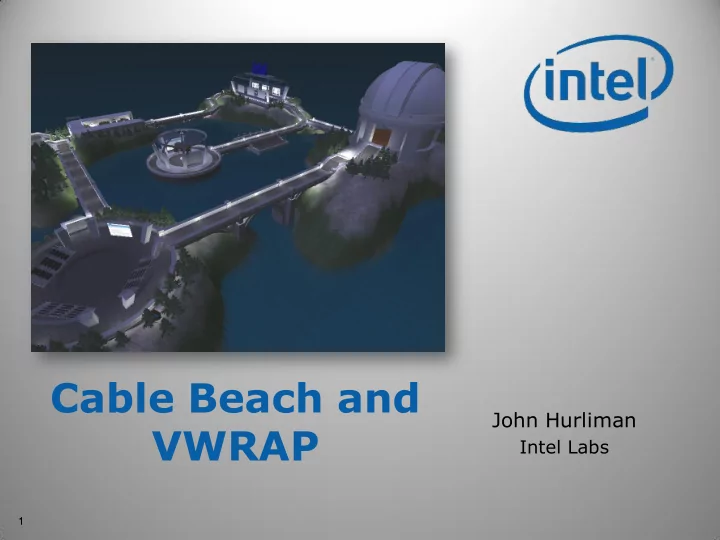

Cable Beach and John Hurliman VWRAP Intel Labs 1
What is Cable Beach? • Researching the next steps in virtual world scalability • How will the introduction of more virtual worlds and larger virtual worlds impact content, identity, and service deployment? • How can we keep innovating without starting over every few years? 2
What was the purpose? • Many similar worlds with common protocols are appearing, but no interoperability • The barrier to entry for running a virtual world is too high • Innovation is difficult without a way to connect different services or introduce new services 3
The vision • Millions of independent virtual worlds – Many will join common trust domains or subscribe to trust brokers, many will remain completely independent • Moving between worlds as seamlessly as possible – Federated identity, service delegation • Sharing services between worlds 4
Why a separate project? • Originally unclear whether the projects had common goals • Keep the research flexible. Provide input to VWRAP without setting the direction • The opportunity to start from scratch 5
The project history • Cable Beach Asset Server • Cable Beach Grid Services • Cable Beach Core 1.0 • realXtend’s Naali/Taiga • MMOX->OGPX->VWRAP 6
Lessons learned: assets • Lots of data, caching is critical, has access control list requirements • This is a content distribution network, we can leverage existing solutions • How do we design the rest of the system to work well with existing solutions? 7
Lessons learned: inventory • If assets are blocks of data, the inventory service provides inodes • By moving all of the mutable metadata for assets into the inventory layer you open the door to immutable content optimizations • It’s difficult to separate the data and the inodes into separate trust domains when there are access restrictions 8
Lessons learned: identity • Virtual world identity is a rich set of data – Name and profile – Avatar appearance – Presence • Federated identity is only one piece of the puzzle • Service delegation gets us closer to the goal 9
Lessons learned: cross-domain services • World administrators need policy controls over what services can and can’t be used in their worlds • Users need the ability to bring their own preferred services (if the destination world allows it) • Tying preferred services to identity is a natural fit for the current direction of VWRAP • OAuth WRAP was the best match for our requirements 10 10
Implementing LLSD/LLIDL • LLSD is relatively easy to implement and provides a useful type system on top of loosely structured (JSONish) data • Pruning out default values and using JSON or binary encoding produces reasonably efficient serializations • LLIDL seems mostly useful as a human-readable interface description language and possibly in unit testing. Is there a use case where this would be deployed in production services? 11 11
Implementing web authentication • Moving authentication from the rich client to the web simplifies the implementation – Supporting OAuth, CAPTCHAs, Terms of Service agreements, etc. with a rich client is possible, but not preferable for prototyping • We invented the cablebeach:// URI for testing, the VWRAP launch document replaces this • Best practices for OAuth logins are still being fleshed out by the web community 12 12
Implementing OGPX (VWRAP) • I built a region domain in C# to better understand the OGP drafts and test the Snowglobe implementation • Even with OGP drafts, the spec is not complete enough to implement • VWRAP documentation needs an overhaul. Aggregate the current docs and prune outdated information 13 13
Merging Cable Beach and VWRAP • The Cable Beach research project is now entirely folded into VWRAP development efforts • Working with the Open Metaverse Foundation and OpenSim community to build a new virtual world backend: SimianGrid • The existing Cable Beach code and region domain implementation are being ported to SimianGrid 14 14
The new platform: SimianGrid • A set of virtual world backend services written in PHP. Natively supported in the latest OpenSim • Implements the Second Life / OpenSim model of providing centralized agent domain services to a grid of simulators • Generic enough to support simulators other than OpenSim (originally tested with Simian) • Currently in beta grid deployments, ironing out bugs • A good candidate for a VWRAP region domain implementation 15 15
SimianGrid needs developers! • Initial development has focused on reducing the barrier to entry for developers – Open Metaverse Foundation project. BSD licensed – Widely used language (PHP) with few external dependencies – Complete API documentation – Small but active developer community • VWRAP is flexible. We need to prioritize which policy controls and deployment patterns are supported first http://openmetaverse.googlecode.com/ #vwrap on Freenode 16 16
Recommend
More recommend